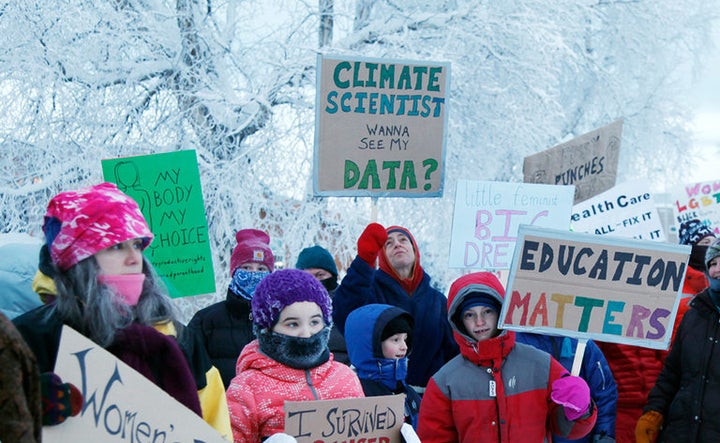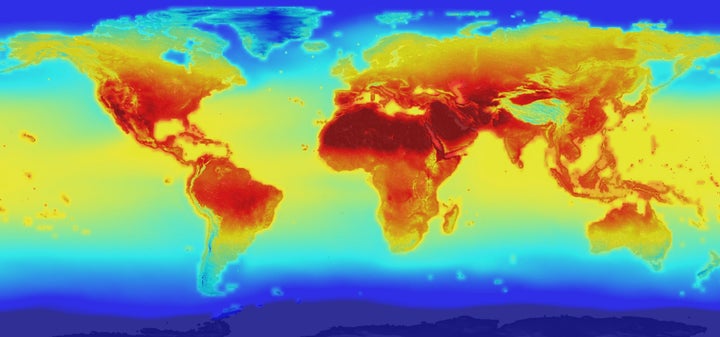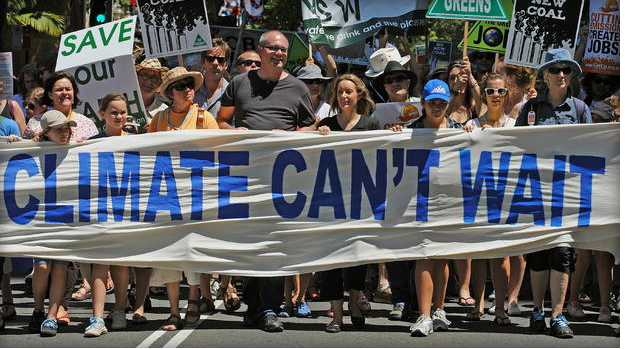
Education Matters. Earth Day protest in Fairbanks, Alaska.
James Sutter is a science teacher at Wellston High School, student population less than 500. Wellston, Ohio is a town of a little more than 5,000 people in southeastern Ohio near the West Virginia border. The town is 98 percent white and mostly Protestant. Only 12.7 percent of adults in the town age 25 or older have at least a college degree compared to almost one of three adults in the United States as a whole. Most students are from families that live below the poverty line. Wellston, located in Jackson County, used to be coal country and it is now Trump country. Donald Trump got 73 percent of the presidential votes cast in Jackson County in 2016.
According to a recent article in the New York Times, Mr. Sutter has been having difficulty with some of the students in his classes, and their parents, because, like the President of the United States, they reject the reality of climate science. The article cited a specific conflict between Sutter and one of his students. When he “ascribed the recent warming of the Earth to heat-trapping gases released by burning fossil fuels like the coal her father had once mined, she asserted that it could be a result of other, natural causes.”
In addition, “When he described the flooding, droughts and fierce storms that scientists predict within the century if such carbon emissions are not sharply reduced, she challenged him to prove it.” This student was only the “most vocal of a raft of student climate skeptics.”
During one interchange, the student insisted that teachers “are supposed to be open to opinions.” Sutter responded, “It’s not about opinions. It’s about the evidence.” She answered, “It’s like you can’t disagree with a scientist or you’re ‘denying science.”’ On another occasion, the student, who was academically very strong, grew so agitated that she stormed out of the room.

Mapping rising temperatures caused by burning fossil fuels.
The Times article attributed the battles in Mr. Sutter’s classroom to the “culture wars” being played out in the United States. In a 2016 Pew public opinion poll only 22 percent Trump supporters believed that human activity is warming the planet. The Heartland Institute, which receives major funding from the fossil fuel industry, has distributed tens of thousands of copies of their propaganda material challenging climate science to teachers in an effort to undermine support for reigning in pollution, cutting back on the use of fossil fuels, and reversing climate change before there is a global disaster.
The kind of issues raised in Mr. Sutter’s classroom are not just limited to disputes about climate change or to science classes. Creationist forces have long fought against the teaching of human evolution as part of the biology curriculum. In social studies classes during the last election cycle, some students echoed one of the Presidential candidates, repeating unsubstantiated claims they heard or read in alt-media.
As a teacher educator I offer the following advice to pre-service and beginning teachers who face determined student, parent, and even administrative challenges that interfere with their ability to teach the mandated curriculum. I think this advice would be useful for Mr. Sutter.
1. You need to know your stuff, to do the research, to collect and evaluate the data, and to organize how it will be presented to students. It is okay to express uncertainty, but be clear about why you are uncertain and what more you feel you need to know.
2. Science is never about 100% certainty, but there are things scientists are really, really sure about. Science is always about making decisions based on experimentation, evidence, and consistent explanations.
3. Explain to students the purpose of what they are studying. Every class has an established curriculum. In this case, Mr. Sutter’s curriculum is understanding climate science, particularly evidence of the impact of human action on the environment. Information, analysis, and discussion must be consistent with established scientific principles and procedures and explanations must be based on evidence. The purpose of the curriculum in this case is to understand what scientists know about climate change and how they arrived at these conclusions.
According to the State of Ohio Science Learning Standards: “Contemporary studies regarding global climate must be based on facts and evidence.” In high school, students are expected to be able to: Identify questions and concepts that guide scientific investigations; Design and conduct scientific investigations; Use technology and mathematics to improve investigations and communications; Formulate and revise explanations and models using logic and evidence (critical thinking); Recognize and analyze explanations and models; and Communicate and support a scientific argument.” The guidelines for Environmental Science include a section titled “Common Misconceptions.” It recognizes that “Students may have difficulty separating science from non-science factors as they relate to the different parts of the environment. It is important to distinguish “what is science” and therefore, what will be included in an environmental science class, especially as it relates to climate change and evolution. Identifying and understanding personal bias and ethical issues are an important step in recognizing science.” Additionally, “it is important to provide evidence of climate change throughout Earth’s history and current data to document temperature changes (surface and oceanic).”
4. It is crucial to establish guidelines for discussion. An important goal is to develop a classroom community where students are able to listen to each other and the teacher and to explore the curriculum together. No student, or group of students, has the right to monopolize discussion, to silence others, or to prevent a class from proceeding. Mr. Sutter and every teacher should welcome student questions, but questioning should not become a technique for disruption.
5. It is important for students who dissent from the curriculum or teacher presentations to feel they are respected and have a place in classroom discussion. In this case, I would offer the dissenting student or students the opportunity to conduct research and prepare a report explaining their critique of climate science. I would help the dissenters evaluate data and alternative explanations for climate change and if their reports were well-organized and consistent with the curriculum and established scientific practice, I would set aside time for the student or students to present in class and for the class to discuss their alternative perspective. This approach could have prevented must of the difficulties described in the Times article.
Follow Alan Singer on Twitter: https://twitter.com/ReecesPieces8

Earth Day marchers in Sidney Australia
